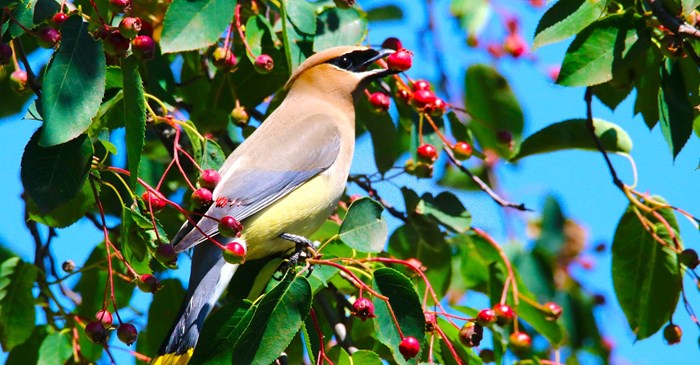If you’re looking for some bird-friendly plantings to include in your landscaping, one species you might want to target is the Cedar Waxwing.
These were named for their red wingtips, which appear to have been dipped in sealing wax. These handsome birds are decked out in a silky smooth plumage of soft browns and grays, with a black bandit mask and bright yellow tail tip.
These songbirds are most common in the northeast and Great Lakes region, but are found throughout North America, favoring places with plenty of trees and bushes, especially those that bear fruit.
As frugivores (fruit eaters), these birds survive the cold winters with fruits and berries, though some will migrate to Mexico. Though they eat plenty of insects in the warm months, they raise their nestlings on a fruit diet.
Unlike many other songbirds, the Cedar Waxwing’s behavior won’t transition from wintertime flocking (to forage for food as a group) to springtime's territorial tendencies (defending mates and nesting sites from competitors). They live within flocks year-round. Though monogamous, they build their nests near each other, as small groups.
To draw more Cedar Waxwings into your yard, consider native trees and shrubs that produce fruit they can eat in one gulp. These lists offer a few suggestions, but consult with your local community gardening resources to help you find species that would work well with your yard's specific conditions.
Trees
- Crabapples (A "persistent" species is ideal for these birds, as they don't drop fruit.)
- Mulberry
- Flowering dogwood
- Eastern red cedar
- Juniper
- Serviceberry
- Mountain ash
- Madrone
Shrubs & Plants
- Nannyberry
- Winterberry (Note: Only females make the berries, so mix in one male plant with several females)
- Hawthorn
- Elderberry
- Raspberries
Feeder
The Cedar Waxwing is also a feeder visitor. Fill your hopper feeder with a premium blend that contains plenty of dried fruit, such as Lyric Fruit & Nut Mix, which has dried cranberries and raisins.
